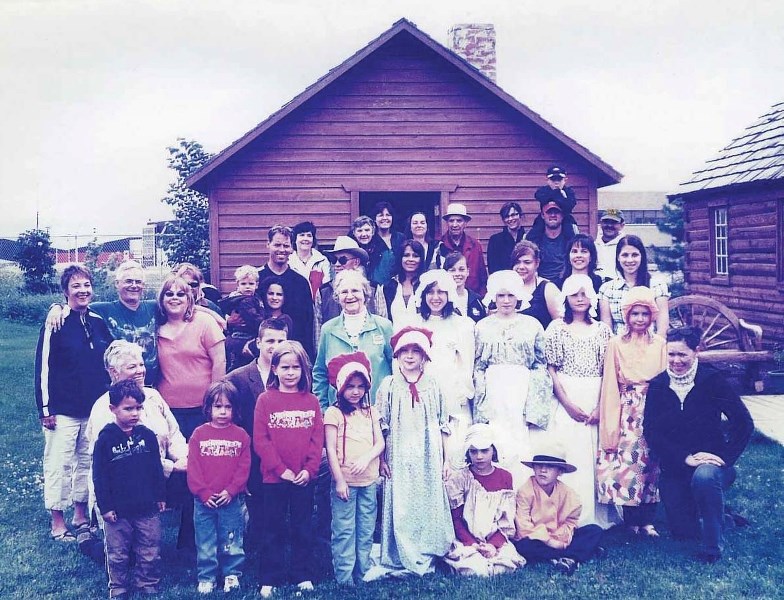Back in the early years of the 20th century, years before the Town of Bonnyville even existed, the area between Moose Lake and what is today known as Fort Kent was sparsely dotted with dwellings and buildings built almost exclusively in the tradition
Back in the early years of the 20th century, years before the Town of Bonnyville even existed, the area between Moose Lake and what is today known as Fort Kent was sparsely dotted with dwellings and buildings built almost exclusively in the traditional log house form.
But in 1908, along came a young pioneer named Wilfred Genereux and an idea to build the area's first framed building.
Working with lumber purchased from nearby St. Paul des Métis, the 16-year-old Genereux constructed a modest home, located about three kilometers outside of modern-day Bonnyville and measuring about 12 by 20 feet, which he finished later that year.
The original building, maintained and restored throughout the years by Omer Croteau followed by his son Lou, now sits at the Bonnyville and District Museum.
Although he built the area's first framed building, Genereux did not live in it for long, leaving soon after its construction for work in the booming village of Vegreville.
In 1909, the land was opened up to further homesteading, which attracted another young pioneer named Omer Croteau.
Croteau came to Alberta from Quebec as a 16-year-old and upon his arrival to the Moose Lake area he began to look for his new home.
Croteau eventually decided upon the vacated home built by Genereux, buying it from him for $35.
Over the next few years, Croteau improved upon the building, opened up the land for farming, planted grains and eventually married a young woman named Anne-Marie Mercier on Nov. 26, 1913.
To support himself and his new wife, Croteau hauled frozen fish from Primrose Lake to Vegreville in exchange for an income.
On May 7, 1915 the Croteau's had their first child, Irene, who was followed in order by Janet, Lucien, Lou, Marcel, Therese, Raymond, Clare, Andre, Paul and finally Joanne.
The Croteau's were not alone in having a large family, as their neighbours down the road had 13 children.
The first two Croteau children lived with their parents inthe family's first home, originally built by Genereux, but soon after Omer bought a larger home to accommodate his growing family.
The original home was eventually converted into a summer kitchen shack, set alongside the larger home for the family's use.
In 1939, after remodeling the family's larger home, the Croteau's moved the original building to their son Lou's farmland, located about two miles east and four miles north of Bonnyville.
Lou Croteau took on many jobs as a young man, but the original framed building, built back in 1908, became his home while he was in the area farming his land and raising his horses.
In 1945 he married Theresa Fontaine.
Soon after they were married, the Croteau's had children of their own and built a new larger home on the farm for his growing young family.
With little use for the original home, Croteau moved it into the bush on the edge of their property, leaving it there for more than two decades. Croteau said the entire time it was stored in the bush, the building "never once had a leak in the roof. It was very well-built."
In 1969, Croteau decided to begin restoring the original building. So he had it lifted onto used telephone poles, which acted as a skid, and with a team of horses he pulled the building out of the bush and over to his son Giles' property. Upon arrival, Croteau said, "There wasn't much left of those poles."
He spent parts of the next year, putting in over 300 hours, restoring the building back to its original quality and form.
By the 1980s Croteau had long established himself and his family in Bonnyville and looking for a way to contribute and improve his community, he began work on creating the town's first museum.
He spent years fundraising, signing up members and creating a historical society and was eventually successful in negotiating a deal with town council to purchase the land today's museum is located on.
Once the land was filled and leveled, using hundreds of loads of dirt and clay, which Croteau oversaw, the process of building the museum could begin.
In 1990, Croteau was named Bonnyville's Citizen of the Year for his work in building the town's first museum.
His next step was to move his original home, the area's first framed building, to sit alongside the main building and the large shed for the Bonnyville and District Museum's grand opening in 1991.
"Lou was a driving force behind the museum," said Bonnyville's former director of planning and development Bob Hogg. "He was a man of action, it was impressive. He would say he is going to do something and then he would do it."
The area's first framed building turns 105 years old this year and still sits alongside other historical buildings on the grounds of the town's museum, which Croteau, now 93, continues to contribute to as a board member.
The museum is scheduled to open for another season on May 18.
